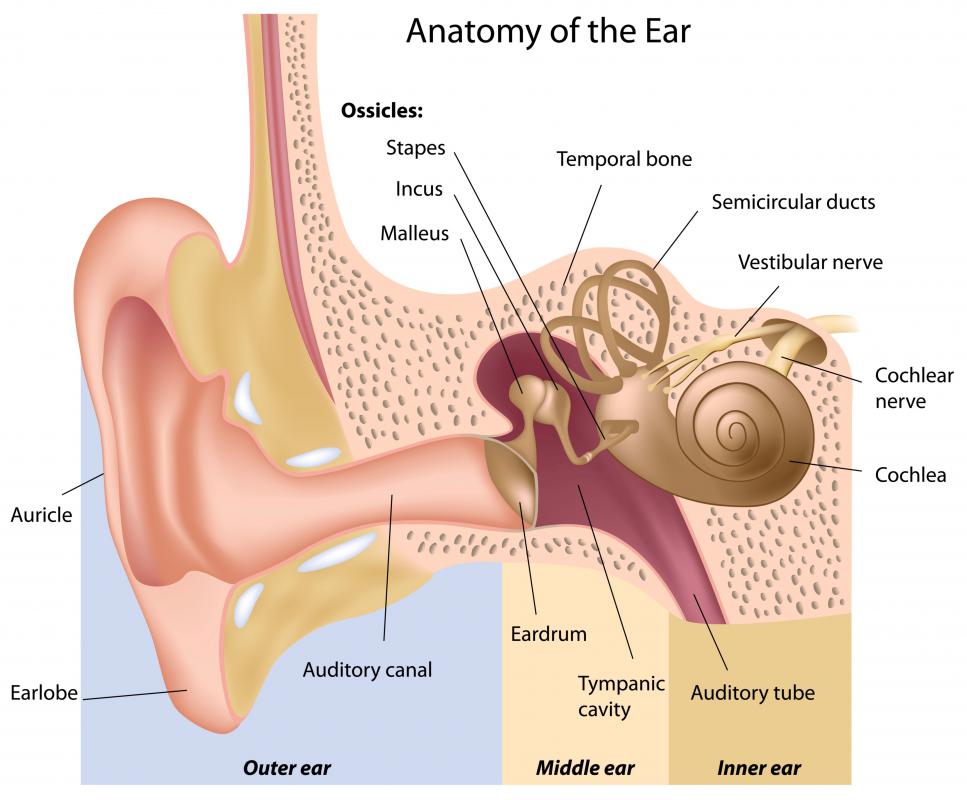At TheHealthBoard, we're committed to delivering accurate, trustworthy information. Our expert-authored content is rigorously fact-checked and sourced from credible authorities. Discover how we uphold the highest standards in providing you with reliable knowledge.
What is the Cochlear Nerve?
The cochlear nerve, which is also referred to as the acoustic nerve or auditory nerve, is the nerve that carries auditory information from the cochlea to the brain. It is a sensory nerve, meaning that its role is to gather information, specifically sound, from the environment and transmit it to the brain for processing. The cochlear nerve begins at the cochlea, the auditory section of the inner ear, and extends to the brain stem, the small part of the brain through which motor and sensory nerves pass. It is a part of the overall auditory system, which is composed of many different parts that all work toward the goal of hearing effectively.
The mechanism by which the cochlear nerve functions can be very complicated, but there are a few simple points that are essential to the process. First, sound in the form of vibrations hits the tympanic membrane, or ear drum, and is, with the assistance of other parts of the ear, converted to electrical form. The electrical signal travels along the cochlear nerve and into the brain, where it can be processed into a form that is understandable to the mind. In the brain, the input from the two ears is processed and merged into an understandable stream.

There are some hearing aids that exist in the form of cochlear implants and make up for lost functionality in the cochlear nerve. Such implants can be adjusted in many different ways based on the degree of hearing loss, which can range from very minor to total deafness. Cochlear implants are made up of a few different parts. A microphone picks up the sound, a speech processor processes it into electrical data that can be understood by the brain, and devices under the skin interface with the cochlea and allow the sending of auditory information to the brain. As with any surgical procedure, the insertion of a cochlear implant can lead to further impairment, infection, or more serious problems.

There are many different diseases and disorders that can affect different nerve cells, including the cochlear nerve. Such diseases and disorders act in different ways and can have different causes; some kill the nerves entirely while others damage them and impair their functionality. When this occurs to nerves in the auditory system, hearing loss can occur, necessitating treatment that may include the use of hearing aides. Cochlear implants are generally very effective, and can restore a great deal of lost hearing capability.
AS FEATURED ON:
AS FEATURED ON:

















Discussion Comments
@Proxy414
This is interesting because what you are saying is that essentially, when a person speaks into a microphone, the sound waves go from being sound waves to being electromagnetic, then back to sound waves, then again are transmitted to electric in the human ear. It is like a multi-tiered process of transmission to reach the human mind and cause effective communication.
The human cochlear nerve works somewhat like an amplification system. When you speak into a microphone, your sound waves are converted into an electromagnetic signal which is amplified and re-transmitted to an audio signal in a speaker. The ear also receives sound waves in the air and converts them to an electrical signal which is readable by the brain.
Post your comments